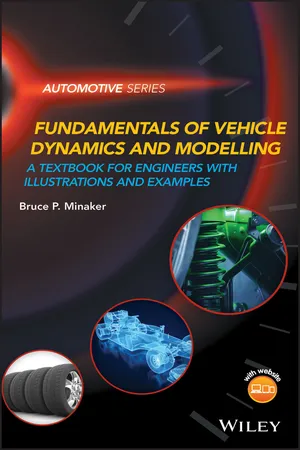
Fundamentals of Vehicle Dynamics and Modelling
A Textbook for Engineers With Illustrations and Examples
- English
- ePUB (mobile friendly)
- Available on iOS & Android
Fundamentals of Vehicle Dynamics and Modelling
A Textbook for Engineers With Illustrations and Examples
About this book
An introduction to vehicle dynamics and the fundamentals of mathematical modeling
Fundamentals of Vehicle Dynamics and Modeling is a student-focused textbook providing an introduction to vehicle dynamics, and covers the fundamentals of vehicle model development. It illustrates the process for construction of a mathematical model through the application of the equations of motion. The text describes techniques for solution of the model, and demonstrates how to conduct an analysis and interpret the results. A significant portion of the book is devoted to the classical linear dynamic models, and provides a foundation for understanding and predicting vehicle behaviour as a consequence of the design parameters.
Modeling the pneumatic tire is also covered, along with methods for solving the suspension kinematics problem, and prediction of acceleration and braking performance. The book introduces the concept of multibody dynamics as applied to vehicles and provides insight into how large and high fidelity models can be constructed. It includes the development of a method suitable for computer implementation, which can automatically generate and solve the linear equations of motion for large complex models.
Key features:
? Accompanied by a website hosting MATLAB® code.
? Supported by the Global Education Delivery channels.
Fundamentals of Vehicle Dynamics and Modeling is an ideal textbook for senior undergraduate and graduate courses on vehicle dynamics.
Frequently asked questions
- Essential is ideal for learners and professionals who enjoy exploring a wide range of subjects. Access the Essential Library with 800,000+ trusted titles and best-sellers across business, personal growth, and the humanities. Includes unlimited reading time and Standard Read Aloud voice.
- Complete: Perfect for advanced learners and researchers needing full, unrestricted access. Unlock 1.4M+ books across hundreds of subjects, including academic and specialized titles. The Complete Plan also includes advanced features like Premium Read Aloud and Research Assistant.
Please note we cannot support devices running on iOS 13 and Android 7 or earlier. Learn more about using the app.
Information
1
Introduction
- Tires The development of mathematical models to predict tire forces, often based on empirical or semi‐empirical techniques, i.e., not derived from first principles, but rather measurements of tire properties and data from experiments
- Longitudinal dynamics Acceleration and braking capability, coupling between engine and vehicle through the drivetrain, and weight transfer effects on tire traction
- Ride quality A study of vertical dynamics and the ability of the vehicle's suspension to accommodate varying terrain while maintaining passenger comfort
- Handling The behaviour of the vehicle with respect to its motion in the plane of the road, particularly its directional stability and its response to steering inputs
- Suspension kinematics The geometry of the suspension and steering components, and its effects on vehicle motion; sometimes expanded to include elastokinematics, the small changes in the geometry due to deflection under load
1.1 Past, Present, and Future
- Maurice Olley An outstanding engineer, his numerous accomplishments during his work for Rolls‐Royce, General Motors and others are detailed in the book Chassis Design: Principles and Analysis Based on Maurice Olley's Technical Notes [11]. The results of his experiments in ride quality are still cited as the Olley ‘Flat Ride’ guidelines. Credited with the introduction of independent suspension in American cars, he was twice awarded the Crompton Medal, the highest award of the Institution of Automobile Engineers.
- Leonard Segel In 1956, he published the landmark paper ‘Theoretical prediction and experimental substantiation of the responses of the automobile to steering control’ [2]. His work was instrumental in understanding the motion and behaviour of road vehicles.
- J.R. Ellis Author of the classic 1969 text Vehicle Dynamics [3], and its follow‐up Vehicle Handling Dynamics [9] in 1994.
- Robin Sharp In addition to his numerous papers on automobile dynamics, he was a pioneer on the study of motorcycle dynamics. He wrote the 1971 paper ‘The stability and control of motorcycles’ [4].
- David Crolla An expert in both road and off‐road vehicle dynamics, his publication record includes some two hundred journal and conference papers. He served on the editorial boards of several journals, including Proceedings of the IMechE Part D, Heavy Vehicle Systems, and the International Journal of Automotive Technology.
- Carol Smith Well known for his extensive hands‐on experience and love of motorsport. He wrote the widely acclaimed Tune to Win [5] series of handbooks, which have motivated thousands of motor racing enthusiasts to study vehicle dynamics and engineering.
- JY Wong An expert in terramechanics and off‐road vehicles, and author of the widely cited text Theory of Ground Vehicles [6].
- Hans Pacejka Developer of the now widely used ‘magic’ tire model, introduced in the 1987 paper ‘Tire modelling for use in vehicle dynamics studies’ [7], and further expanded in his text Tire and Vehicle Dynamics [12].
- T.D. Gillespie The author of the text Fundamentals of Vehicle Dynamics [8], which was published by SAE and was a staple in the US auto industry for many years.
- Bill Milliken The developer of the Milliken Moment Method, some say he invented the science of automobile handling. He's the co‐author of the widely used text Race Car Vehicle Dynamics [10], and his own autobiography is given in Equations of Motion: Adventure, Risk and Innovation [13].
Table of contents
- Cover
- Table of Contents
- Preface
- List of Symbols
- 1 Introduction
- 2 Tire Modelling
- 3 Longitudinal Dynamics
- 4 Linear Dynamic Models
- 5 Full Car Model
- 6 Multibody Dynamics
- 7 Mathematics
- Appendix A: Numerical Methods
- Index
- End User License Agreement